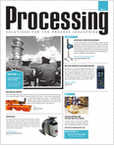Sunday, February 15, 2009
Display problem ? Click HERE
Recommended :
Tips on Succession in FREE Subscription
Subscribe FREE - Processing Magazine
 American Petroleum Petroleum (API) released the API Std 520 Part 1, Sizing, Selection and Installation of Pressure-relieving Devices in Refineries Part 1 - Sizing and Selection Eighth Edition, Dec. 2008 in December 2008. First far most important change is it became a STANDARD, instead RECOMMENDED PRACTICES. User shall remember although it became a standard, it is solely users responsibility to make sound, scientific, engineering, safe, environment friendly judgment. Neither API nor its employee, etc make warranty for the use of this standard. Detail refer to "Special Note" in relevant Standard.
American Petroleum Petroleum (API) released the API Std 520 Part 1, Sizing, Selection and Installation of Pressure-relieving Devices in Refineries Part 1 - Sizing and Selection Eighth Edition, Dec. 2008 in December 2008. First far most important change is it became a STANDARD, instead RECOMMENDED PRACTICES. User shall remember although it became a standard, it is solely users responsibility to make sound, scientific, engineering, safe, environment friendly judgment. Neither API nor its employee, etc make warranty for the use of this standard. Detail refer to "Special Note" in relevant Standard.
Applicability
User of this standard shall understand the applicability of this standard.
This standard
Quick glance through this document, several section are revised/added. The updated / added sections are (not limted to) :
Tips on Succession in FREE Subscription
Subscribe FREE - Processing Magazine
 American Petroleum Petroleum (API) released the API Std 520 Part 1, Sizing, Selection and Installation of Pressure-relieving Devices in Refineries Part 1 - Sizing and Selection Eighth Edition, Dec. 2008 in December 2008. First far most important change is it became a STANDARD, instead RECOMMENDED PRACTICES. User shall remember although it became a standard, it is solely users responsibility to make sound, scientific, engineering, safe, environment friendly judgment. Neither API nor its employee, etc make warranty for the use of this standard. Detail refer to "Special Note" in relevant Standard.
American Petroleum Petroleum (API) released the API Std 520 Part 1, Sizing, Selection and Installation of Pressure-relieving Devices in Refineries Part 1 - Sizing and Selection Eighth Edition, Dec. 2008 in December 2008. First far most important change is it became a STANDARD, instead RECOMMENDED PRACTICES. User shall remember although it became a standard, it is solely users responsibility to make sound, scientific, engineering, safe, environment friendly judgment. Neither API nor its employee, etc make warranty for the use of this standard. Detail refer to "Special Note" in relevant Standard.Applicability
User of this standard shall understand the applicability of this standard.
This standard
- applies to the sizing and selection of pressure relief devices (PRD) used in refineries and related industries for equipment that has maximum allowable working pressure (MAWP) of 15 psig (103 kPag) or greater
- applicable to PRD protecting unfired pressure vessels and related equipment
- applicable to steady state flow of Newtonian fluids
- supplement to ASME Section VIII Pressure Vessel Code
- is not applicable Atmospheric or Low pressure storage tank (cover under API Std 2000)
- is not applicable fired vessels (cover under ASME section 1 and ASME B31.1)
Quick glance through this document, several section are revised/added. The updated / added sections are (not limted to) :
- 3. Terms and Definitions (Revised - all definition are in sorted alphabetically)
- 4.2.1.3 Balanced PRVs (Revised)
- 4.2.2.3 Pilot Types (Revised)
- 4.2.2.5 Pilto-operated PRV Accessories (Added/revised)
- 4.2.3 Cold Differential Test Pressure (CDTP) (Shifted)
- 4.4.2.1.1 Buckling pin devices... (revised)
- 4.4.2.1.3 ASME Code Case 2091-3 defines... (Added)
- 4.4.2.2.1 The set pressure... (Revised)
- 4.4.3.2 & 4.4.3.3 Breaking pin... (Revised)
- 5.3.2.2 ...a) bench set pressure... (Revised)
- 5.3.4.2 Total backpressure... (Revised)
- 5.4.1.4 ...(Partly revised)
- 5.5 Development of Sizing Equations (New)
- 5.6.1 Applicability (New)
- 5.6.4.3 Balanced PRVs (New)
- 5.6.5 Alternate Sizing Procedure (New)
- Annex B (Revised)
Comments
There are several remarks that you may take note (when this standard is apply) :
- Use of isentropic nozzle flow method and/or ideal gas specific heat ratio for vapor relief estimation
- Use of Homogeneous Equilibrium Model (HEM) based on thermal and mechanical equilibrium for two phase relief. Nevertheless, the Leung Omega Two point method is still remained as a choice of method.
- Generally thermal and mechanical equilibrium can be achieved for PRV relief nozzle length more than 100mm. If shorter nozzle is used, Homogeneous Non-equilibrium Model (HNE) may be considered.
- Additional attention shall be taken when appreciable of non-condensable gas present in the flashing liquid. Leung Omega Two Point method for flashing liquid and non-condensable gas may be referred.
- Used of HEM method is easy but rigorous. Understanding of the thermal equilibrium for fluid properties is important and required.
- Two phase Vapor Liquid Relief method presented in Annex B have not been validated by test (accoring to API) and there is no any recognized procedure for certifying the capacity of PRVs in two phase flow service.
Related Topics
- API Std 521 ADDENDUM, MAY 2008 - Check Out Revised Section
- Workbook for Chemical Reactor Relief System Sizing
- A must have book...Emergency Relief System Design Using DIERS Technology
- Requirement of overpressure protection devices on system design to PIPING code
- Discussion on ISENTROPIC and ISENTHALPIC process via Relief Valve
Labels: Overpressure Protection, Pressure Relief Device

1 Comments:
Mekaster Engineeing Ltd has free API 520 based calculation and sizing software. Click on the link to downnload
Post a Comment
Let us know your opinion !!! You can use some HTML tags, such as <b>, <i>, <a>
Subscribe to Post Comments [Atom]
Home:
<< Home